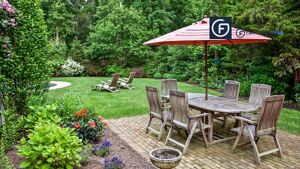Pea gravel is a versatile and affordable material that has become increasingly popular in landscaping projects. It is a type of small, rounded gravel often used for pathways, driveways, and as a decorative element in gardens. If you are considering using pea gravel in your landscaping project, this comprehensive guide will provide you with all the information you need.
Introduction to Pea Gravel
Definition and Characteristics of Pea Gravel
Pea gravel is a type of small, rounded stone often used in landscaping projects. It is named for its size, typically between 1/8 and 3/8 inches in diameter. The stones are smooth and often come in a range of earthy tones, such as beige, tan, and grey. Pea gravel is made from natural stones collected from riverbeds or other natural sources.
One of the defining characteristics of pea gravel is its round shape. This is due to the natural process of erosion that the stones undergo as they are moved by water or wind. The smoothness of the stones is also a result of this process. Therefore, pea gravel is often compared to other types of stone, such as crushed rock or gravel, which have a more angular shape.
Types of Pea Gravel
Several different types of pea gravel are available for use in landscaping projects. These include:
River Rock Pea Gravel: This type of pea gravel is collected from riverbeds and has a natural, earthy appearance.
Pea Pebbles: These are small, rounded stones typically used as a decorative element in gardens or as a ground cover.
Crushed Stone Pea Gravel: This type of pea gravel is made by crushing larger stones and is often used as a base material for driveways and other paved areas.
Uses for Pea Gravel
Pea gravel is a versatile material used in various landscaping applications. Some of the most common uses for pea gravel include:
Pathways: Pea gravel can be used to create a natural-looking pathway through a garden or yard.
Driveways and Parking Areas: Crushed stone pea gravel is often used as a base material for driveways and other paved areas.
Decorative Features: Pea gravel can be used as a decorative element in gardens or as a ground cover around trees or other plants.
Patio and Seating Areas: Pea gravel can create a seating area or patio in your yard.
Advantages of Pea Gravel Bulk
Cost-Effective
One of the main advantages of using pea gravel in your landscaping project is that it is cost-effective. Pea gravel is often more affordable than other types of stone, such as flagstone or pavers. It is an ideal choice for homeowners who are working within a limited budget.
Low Maintenance
Another benefit of pea gravel is its low-maintenance nature. Unlike grass or other ground covers, it does not require watering or mowing, making it a hassle-free option. It also does not require regular fertilization or pest control measures. Pea gravel will naturally settle over time but can be easily raked back into place as needed.
Easy Installation
Pea gravel is also easy to install, especially when purchased in bulk. The stones can be spread over a prepared surface and levelled with a rake or other tool. It presents an excellent choice for homeowners who wish to undertake a DIY landscaping project.
Aesthetically Pleasing
Finally, pea gravel can be a beautiful addition to any landscaping project. The stones have a natural, earthy appearance that can complement various plants and other features in your yard. Pea gravel is also available in various colours, so you can choose the shade that best matches your design preferences.
Factors to Consider When Buying Pea Gravel Bulk
Quantity Needed
Before purchasing pea gravel in bulk, it is important to calculate the quantity you will need for your project. This will depend on the area size you want to cover and the depth of the pea gravel layer. To begin, measure the length and width of the intended area and then calculate the square footage by multiplying the two numbers together. Next, multiply the square footage by the desired depth of the pea gravel layer to get the cubic footage of pea gravel needed. Remember that a 2-3 inches depth is typically sufficient for most landscaping applications.
Quality of the Pea Gravel
Not all pea gravel is created equal. When purchasing pea gravel in bulk, it is important to consider the stone’s quality. Look for pea gravel that is clean, free of debris, and has a consistent size and shape. Avoid purchasing pea gravel with a lot of fines (small particles), or that is made up of stones of varying sizes.
Delivery and Transportation
Pea gravel can be heavy and bulky, so it is important to consider how you will transport it to your property. Many suppliers offer delivery services for bulk orders, saving you time and effort. Ask about the delivery fee and any other charges that may apply.
Cost
While pea gravel is generally a cost-effective option, it is still important to consider the cost when purchasing in bulk. Compare prices from different suppliers to ensure you get a fair price for the pea gravel you need. Also, remember that delivery fees and the stone’s quality can affect the overall cost.
How to Use Pea Gravel Bulk in Landscaping
Preparation
Before laying down pea gravel, it is important to prepare the area properly. Remove any grass, weeds, or other vegetation from the area and level the ground as much as possible. Consider using a weed barrier or landscaping fabric to prevent weed growth under the pea gravel.
Laying Down the Pea Gravel
Once the area is prepared, it is time to lay down the pea gravel. Start by spreading a layer of pea gravel over the area, using a rake or other tool to spread evenly. Next, use a tamper or other tool to compact the pea gravel layer. Repeat this process until the desired depth is reached.
Maintenance
Pea gravel is a low-maintenance option, but it still requires some upkeep. Over time, the pea gravel may become displaced or compacted, so it is important to rake it back into place as needed. Also, remove any debris or leaves that may accumulate on the surface of the pea gravel to keep it looking clean and neat.
Design Ideas
Pea gravel can be used in various ways to enhance the look of your landscaping. Consider using it to create a natural-looking pathway through your garden or yard. It can also be used as a ground cover around trees or other plants. Pea gravel can be a great option for creating a seating area or patio in your yard, especially when paired with other elements like pavers or outdoor furniture.
Conclusion
Pea gravel is a versatile and cost-effective option for landscaping projects. Pea gravel’s natural appearance and low maintenance requirements make it a popular option among homeowners seeking to elevate their yard’s aesthetics. When purchasing pea gravel in bulk, consider factors such as quantity needed, quality of the stone, and delivery options. When appropriately prepared and installed, pea gravel can be an attractive and practical addition to your landscaping design.









